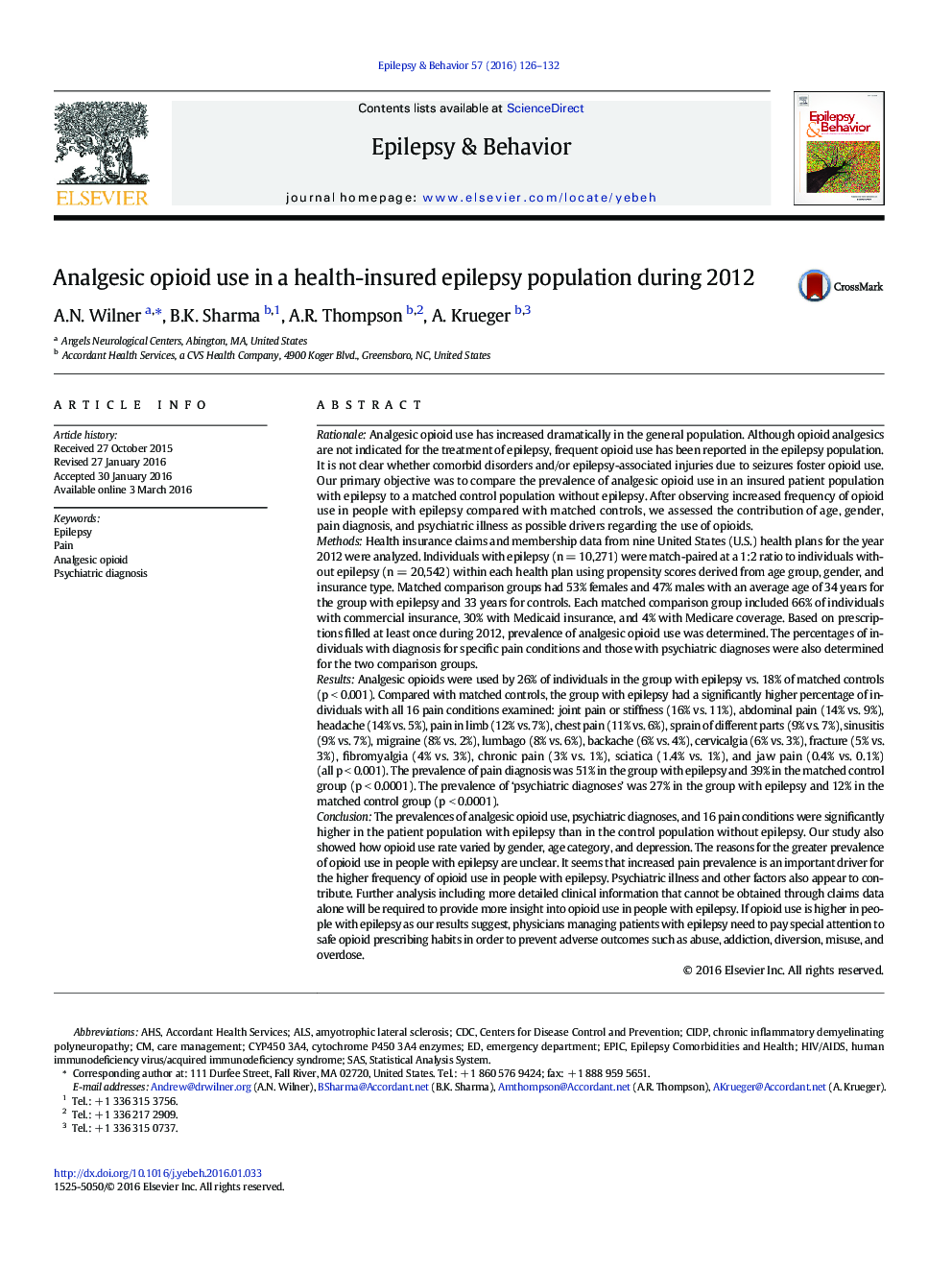| کد مقاله | کد نشریه | سال انتشار | مقاله انگلیسی | نسخه تمام متن |
|---|---|---|---|---|
| 6010234 | 1185874 | 2016 | 7 صفحه PDF | دانلود رایگان |
• Opioids were used by 26% of the group with epilepsy vs. 18% of controls.
• The prevalence of pain was 51% in the group with epilepsy vs. 39% in the control group.
• Among women, opioids were used by 30% with epilepsy vs. 20% of controls.
• Among men, opioids were used by 20% with epilepsy vs. 16% of controls.
• 27% of patients with epilepsy vs. 12% of controls had psychiatric diagnosis.
RationaleAnalgesic opioid use has increased dramatically in the general population. Although opioid analgesics are not indicated for the treatment of epilepsy, frequent opioid use has been reported in the epilepsy population. It is not clear whether comorbid disorders and/or epilepsy-associated injuries due to seizures foster opioid use. Our primary objective was to compare the prevalence of analgesic opioid use in an insured patient population with epilepsy to a matched control population without epilepsy. After observing increased frequency of opioid use in people with epilepsy compared with matched controls, we assessed the contribution of age, gender, pain diagnosis, and psychiatric illness as possible drivers regarding the use of opioids.MethodsHealth insurance claims and membership data from nine United States (U.S.) health plans for the year 2012 were analyzed. Individuals with epilepsy (n = 10,271) were match-paired at a 1:2 ratio to individuals without epilepsy (n = 20,542) within each health plan using propensity scores derived from age group, gender, and insurance type. Matched comparison groups had 53% females and 47% males with an average age of 34 years for the group with epilepsy and 33 years for controls. Each matched comparison group included 66% of individuals with commercial insurance, 30% with Medicaid insurance, and 4% with Medicare coverage. Based on prescriptions filled at least once during 2012, prevalence of analgesic opioid use was determined. The percentages of individuals with diagnosis for specific pain conditions and those with psychiatric diagnoses were also determined for the two comparison groups.ResultsAnalgesic opioids were used by 26% of individuals in the group with epilepsy vs. 18% of matched controls (p < 0.001). Compared with matched controls, the group with epilepsy had a significantly higher percentage of individuals with all 16 pain conditions examined: joint pain or stiffness (16% vs. 11%), abdominal pain (14% vs. 9%), headache (14% vs. 5%), pain in limb (12% vs. 7%), chest pain (11% vs. 6%), sprain of different parts (9% vs. 7%), sinusitis (9% vs. 7%), migraine (8% vs. 2%), lumbago (8% vs. 6%), backache (6% vs. 4%), cervicalgia (6% vs. 3%), fracture (5% vs. 3%), fibromyalgia (4% vs. 3%), chronic pain (3% vs. 1%), sciatica (1.4% vs. 1%), and jaw pain (0.4% vs. 0.1%) (all p < 0.001). The prevalence of pain diagnosis was 51% in the group with epilepsy and 39% in the matched control group (p < 0.0001). The prevalence of ‘psychiatric diagnoses’ was 27% in the group with epilepsy and 12% in the matched control group (p < 0.0001).ConclusionThe prevalences of analgesic opioid use, psychiatric diagnoses, and 16 pain conditions were significantly higher in the patient population with epilepsy than in the control population without epilepsy. Our study also showed how opioid use rate varied by gender, age category, and depression. The reasons for the greater prevalence of opioid use in people with epilepsy are unclear. It seems that increased pain prevalence is an important driver for the higher frequency of opioid use in people with epilepsy. Psychiatric illness and other factors also appear to contribute. Further analysis including more detailed clinical information that cannot be obtained through claims data alone will be required to provide more insight into opioid use in people with epilepsy. If opioid use is higher in people with epilepsy as our results suggest, physicians managing patients with epilepsy need to pay special attention to safe opioid prescribing habits in order to prevent adverse outcomes such as abuse, addiction, diversion, misuse, and overdose.
Journal: Epilepsy & Behavior - Volume 57, Part A, April 2016, Pages 126–132
